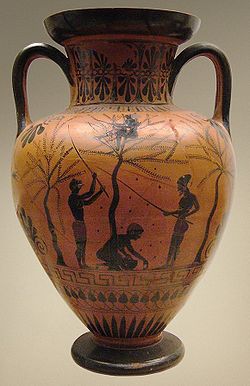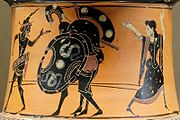
Antimenes painter
Encyclopedia


Attica
Attica is a historical region of Greece, containing Athens, the current capital of Greece. The historical region is centered on the Attic peninsula, which projects into the Aegean Sea...
vase painter of the black-figure style, active between circa 530 and 510 BC.
The real name of the Antimenes Painter is not known; his current name is an archaeological convention. It is derived from the Kalos inscription
Kalos inscription
The Kalos inscription was a form of epigraph found on Attic vases and graffiti in antiquity, common between 550 and 450 BC, and usually found on symposion vessels. The word καλός means "beautiful"; here it had an erotic connotation, and the inscription took the form of a youth's name, in the...
on a hydria
Hydria
A hydria is a type of Greek pottery used for carrying water. The hydria has three handles. Two horizontal handles on either side of the body of the pot were used for lifting and carrying the pot. The third handle, a vertical one, located in the center of the other two handles, was used when...
in Leyden. Of the 150 works ascribed to him, the majority are hydriai and standard amphora
Amphora
An amphora is a type of vase-shaped, usually ceramic container with two handles and a long neck narrower than the body...
e. Most works attributed to him were found in Etruria
Etruria
Etruria—usually referred to in Greek and Latin source texts as Tyrrhenia—was a region of Central Italy, an area that covered part of what now are Tuscany, Latium, Emilia-Romagna, and Umbria. A particularly noteworthy work dealing with Etruscan locations is D. H...
. He is considered to have been connected with the workshop of Andokides
Andokides
Andokides was a famous potter of Ancient Greece. The painter of his pots was an anonymous artist, the Andokides painter, who is recognized as the creater of the red-figure style, beginning around 530 BC. His work is compared with Exekias, who was said to have created the most detailed and best...
.
He depicted the current repertoire of his period: the adventures of Herakles, Dionysos and his companions, and chariot scenes. He varies the themes, his compositions are described as organised. His distinctive motifs are rather idyllic, often including smaller figurines subsidiary to the main narrative. Examples are a well scene on the aforementioned Leyden hydria and a depiction of the olive harvest on an amphora in the British Museum
British Museum
The British Museum is a museum of human history and culture in London. Its collections, which number more than seven million objects, are amongst the largest and most comprehensive in the world and originate from all continents, illustrating and documenting the story of human culture from its...
at London
London
London is the capital city of :England and the :United Kingdom, the largest metropolitan area in the United Kingdom, and the largest urban zone in the European Union by most measures. Located on the River Thames, London has been a major settlement for two millennia, its history going back to its...
.
His drawing style resembles that of Psaix; influences by the early red-figure style are also apparent. Nonetheless, he contined to use the black-figure technique, which maintained many followers. It his hard to distinguish him and associated painters from the Antimenes Painter. Some examples of his later works are striking in the fine and expressive quality of the drawing.

